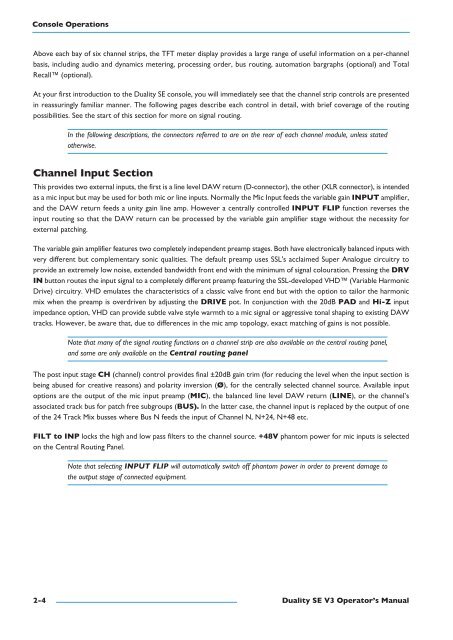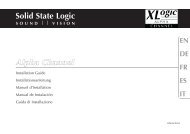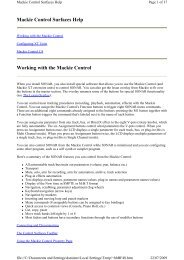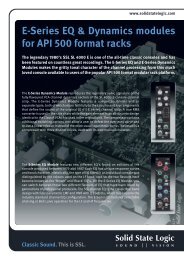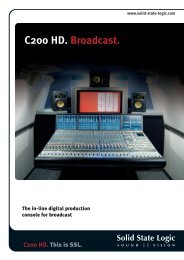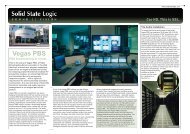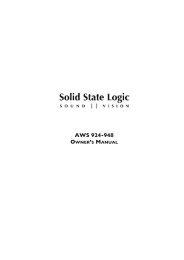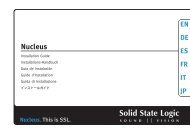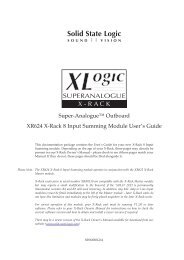Duality SE Operator's Manual - Solid State Logic
Duality SE Operator's Manual - Solid State Logic
Duality SE Operator's Manual - Solid State Logic
You also want an ePaper? Increase the reach of your titles
YUMPU automatically turns print PDFs into web optimized ePapers that Google loves.
Console OperationsAbove each bay of six channel strips, the TFT meter display provides a large range of useful information on a per-channelbasis, including audio and dynamics metering, processing order, bus routing, automation bargraphs (optional) and TotalRecall (optional).At your first introduction to the <strong>Duality</strong> <strong>SE</strong> console, you will immediately see that the channel strip controls are presentedin reassuringly familiar manner. The following pages describe each control in detail, with brief coverage of the routingpossibilities. See the start of this section for more on signal routing.In the following descriptions, the connectors referred to are on the rear of each channel module, unless statedotherwise.Channel Input sectionThis provides two external inputs, the first is a line level DAW return (D-connector), the other (XLR connector), is intendedas a mic input but may be used for both mic or line inputs. Normally the Mic Input feeds the variable gain Input amplifier,and the DAW return feeds a unity gain line amp. However a centrally controlled Input FlIp function reverses theinput routing so that the DAW return can be processed by the variable gain amplifier stage without the necessity forexternal patching.The variable gain amplifier features two completely independent preamp stages. Both have electronically balanced inputs withvery different but complementary sonic qualities. The default preamp uses SSL's acclaimed Super Analogue circuitry toprovide an extremely low noise, extended bandwidth front end with the minimum of signal colouration. Pressing the DrVIn button routes the input signal to a completely different preamp featuring the SSL-developed VHD (Variable HarmonicDrive) circuitry. VHD emulates the characteristics of a classic valve front end but with the option to tailor the harmonicmix when the preamp is overdriven by adjusting the DrIVe pot. In conjunction with the 20dB paD and Hi-Z inputimpedance option, VHD can provide subtle valve style warmth to a mic signal or aggressive tonal shaping to existing DAWtracks. However, be aware that, due to differences in the mic amp topology, exact matching of gains is not possible.Note that many of the signal routing functions on a channel strip are also available on the central routing panel,and some are only available on the Central routing panelThe post input stage CH (channel) control provides final ±20dB gain trim (for reducing the level when the input section isbeing abused for creative reasons) and polarity inversion (Ø), for the centrally selected channel source. Available inputoptions are the output of the mic input preamp (MIC), the balanced line level DAW return (lIne), or the channel’sassociated track bus for patch free subgroups (Bus). In the latter case, the channel input is replaced by the output of oneof the 24 Track Mix busses where Bus N feeds the input of Channel N, N+24, N+48 etc.FIlt to Inp locks the high and low pass filters to the channel source. +48V phantom power for mic inputs is selectedon the Central Routing Panel.Note that selecting INPUT FLIP will automatically switch off phantom power in order to prevent damage tothe output stage of connected equipment.2-4 <strong>Duality</strong> se V3 Operator’s <strong>Manual</strong>


